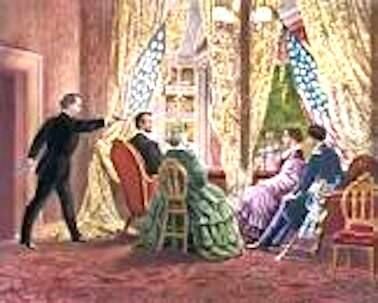April 14 will mark the 160th anniversary of Abraham Lincoln’s assassination at Ford’s Theater. We are all familiar with what happened –– the first murder of a seated president in our nation’s history –– but perhaps you didn’t know that three of the last people to speak to Lincoln at the White House before the president and first lady left for the theater were Nevada County pioneers Richard James Oglesby, William Morris Stewart and Niles Searls.
Oglesby owned a Nevada City general store on Main Street in the early 1850s, but the building and its inventory were lost in a devastating fire. He rebuilt and was again prospering when yet another fire damaged his store, leading to his decision to return home to Illinois.
At about 6:00 P.M. on the evening of April 14, 1865, Oglesby, a Civil War general and then-governor of Illinois, arrived at the White House and Lincoln met with the former Nevada City shopkeeper for nearly an hour.
As the two long-time friends reminisced about their pre-war days in Illinois, Mary Todd Lincoln reminded her husband that it was time for dinner or they would be late to the theater. Oglesby left, never imagining that he would soon be present at the death watch of his friend that ended at 7:22 the following morning.
Also dropping by the White House on the evening of April 14 were two former Nevada County district attorneys: Bill Stewart and Niles Searls.
Stewart, then a senator from the State of Nevada, had been in New York City visiting Searls, who, in 1864, stepped down as judge of the 14th Judicial District –– which included Nevada, Sierra and Plumas counties –– and now owned a farm in the Hudson River Valley.
During the visit, Stewart spoke of his budding personal relationship with Lincoln and told Searls that if they caught a train to Washington, D.C., he would take the former judge to the White House to meet the president –– an offer Searls accepted. They arrived in Washington the following day, and after a nap and dinner headed to the White House.
Once there, Stewart told the doorman why they would like to see Lincoln. He took their calling cards to the president and returned in a few minutes with a note: “I am engaged to go to the theater with Mrs. Lincoln. It is the kind of engagement I never break. Come with your friend tomorrow at ten and I shall be glad to see you,” signed “A. Lincoln.” As he finished reading the note, the president and first lady came out of the White House on the way to their carriage.
“I was intending to pass without interrupting them,” Stewart explained in his memoirs, “but he saw us and extended his hand cordially. I introduced Judge Searls to him. He repeated that he would be glad to see us in the morning, bade us good-night, entered the carriage and drove away. It was the last time I saw him alive.”
Rather than wait until morning, however, Searls reportedly told Stewart, “I have seen Mr. Lincoln; I have had a good look at him, and heard him speak. That is all I came to Washington for.” At that point, Searls decided to return to New York and the two former Nevada County attorneys walked to the railroad depot in time for Searls to catch a northbound train. Soon thereafter, of course, Lincoln was mortally wounded at Ford’s Theater by John Wilkes Booth.
Following the president’s death in the morning, Stewart found himself in a carriage with Chief Justice Salmon Chase, hurrying to the Kirkwood House –– where Vice President Andrew Johnson lived and where Chase administered the oath of office.
There are conflicting accounts of what happened in the chaos that followed, but Stewart, who was present for the swearing-in and subsequent events that day, claimed that Johnson was hungover and had been on a “bender” for a month. “He was dirty, shabby, and his hair was matted, as though with mud from the gutter, while he blinked at us through squinty eyes, and lurched around unsteadily. So far as I am aware,” Stewart wrote, “nobody knows where he spent the night, although his appearance at daylight indicated clearly what he had been doing.”
Stewart said that he and Secretary of War Edwin Stanton took Johnson from the Kirkwood House to the White House, where Stanton ordered that a bath be drawn, then sent for a tailor, barber and doctor. By late afternoon, Stewart claimed, the new president was clean, freshly shaved, sober, and with a new suit of clothes.
And that’s how Nevada County pioneers Richard Oglesby, Bill Stewart and Niles Searls became forever connected with Abraham Lincoln’s final hours.


